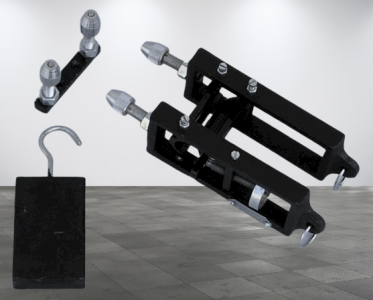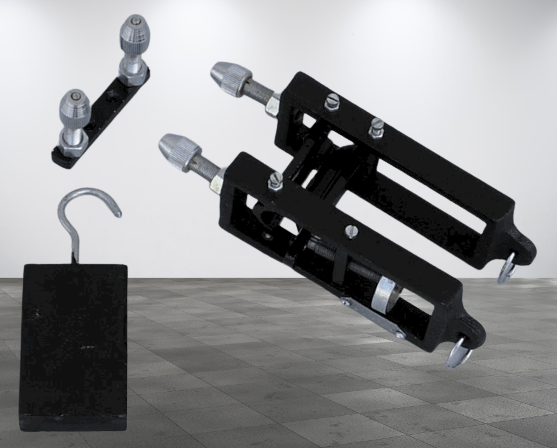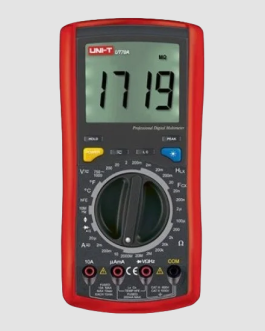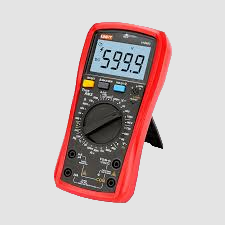Product Page
Young modulus Apparatus in Lahore
Searle’s apparatus is used for the measurement of Young’s modulus. It consists of two equal-length wires that are attached to a rigid support. To understand how Searle’s apparatus is used to determine Young’s modulus of elasticity of the material of a given wire, read the experiment below.
Aim
To determine Young’s modulus of elasticity of the material of a given wire.
Materials Required
- Searle’s apparatus
- Two long steel wires of the same length and diameter
- A metre scale
- A screw gauge
- Eight 0.5 kg slotted weights
- 1 kg hanger
Theory
The normal stress for a wire with length L and radius r is loaded with weight Mg where l is the increase in length, then normal stress is given as:
Y can be calculated as the values of L and r are known and l is found by the known Mg value.
Diagram

Observations
Length of experimental wire AB, L = ….. cm = ……m
Measurement of diameter of the wire
Pitch of the screw gauge (p) = 0.1 cm
No.of divisions on the circular scale = 100
Least count of screw gauge (L.C) = 0.1/100 = 0.001 cm
Zero error of screw gauge (e) = …….cm
Zero error of screw gauge (e) = -e = ……cm
Diameter of experimental wire
| Sl.no | Linear scale reading N (cm) | Circular scale reading | Total reading N+n×(LC)d
(cm) |
|
| No.of divisions on reference line (n) | Value n×(LC)(cm) | |||
| 1. | d1= | |||
| d2= | ||||
| 2. | d3= | |||
| d4= | ||||
| 3. | d5= | |||
| d6= | ||||
| 4. | d7= | |||
| d8= | ||||
| 5. | d9= | |||
| d10= | ||||
Measurement for extension of the wire
Breaking stress for steel (from a table), B = ….. Nm-2
Area of a cross-section of a wire, πr2 = ….. cm2 = …….m2
Breaking load = Bπr2 = …. N
(∵1 kg = 9.8 N)
1/3rd of breaking load = ….kg
Pitch of spherometer screw, (p) = 0.1 cm
No.of divisions in the disc = 100
Least count of spherometer (LC) = 0.1/100 = 0.001 cm
Load and extension
| Sl.no | Load on hanger M (kg) | Spherometer screw reading | Extension for load 2.5 kg l(cm) | ||
| Load increasing x(cm) | Load decreasing y (cm) | Mean z = (x+y)/2 (cm) | |||
| 1. | 0.0 | z1= | |||
| 2. | 0.5 | z2= | |||
| 3. | 1.0 | z3= | |||
| 4. | 1.5 | z4= | |||
| 5. | 2.0 | z5= | |||
| 6. | 2.5 | z6= | l1=(z6-z1)= | ||
| 7. | 3.0 | z7= | l2=(z7-z2)= | ||
| 8. | 3.5 | z8= | l3=(z8-z3)= | ||
| 9. | 4.0 | z9= | l4=(z9-z4)= | ||
Calculations
From table 1
Mean observed diameter of the wire,
Mean corrected diameter of the wire,
d = (d0 + c) = ……cm = ……m
Mean radius of wire,
r = d/2 = ……m
From table 2
Mean extension for 2.5 kg load,
From formula,
Result
- The Young’s modulus for steel as determined by Searle’s apparatus = …….. Nm-2
- Straight-line graph between load and extension shows that stress ∝ strain. This verifies Hooke’s law.
Percentage error
Actual value of Y for steel =…… Nm-2
The difference in values =……… Nm-2
Percentage error = (difference in values)/(actual value) = …….%
It is within the limits of experimental error.
Precautions
- The material, length, and cross-sectional area of both the wires must be the same.
- The same rigid support should be used as a support for both the wires.
- Before starting the experiment, kinks should be removed.
- At different places, the diameter of the wire should be measured.
- Adding and removing the slotted weight should be done gently.
- After every addition or removal of weight, wait for two minutes.
- Increasing or decreasing weights should be done in regular steps.
Sources of Error
- The slotted weights might not be of standard weight.
- The wire used in the experiment may not be of uniform cross-sectional area.
Viva Questions
Q1. State Hooke’s law.
Ans: Hooke’s law states that when the material has a load within the elastic limit, then the stress is directly proportional to the strain.
Q2. What is Poisson’s ratio?
Ans: Poisson’s ratio is defined as the ratio of lateral strain to longitudinal strain and is denoted by μ.
Q3. What is the yield point?
Ans: Yield point is defined as the stress beyond which the material becomes plastic.
Q4. What is the elastic limit?
Ans: Elastic limit is defined as the maximum limit to which a solid can be stretched without any permanent alteration of shape or size.

Young modulus Apparatus in Lahore
[ubk1]







Reviews
There are no reviews yet.